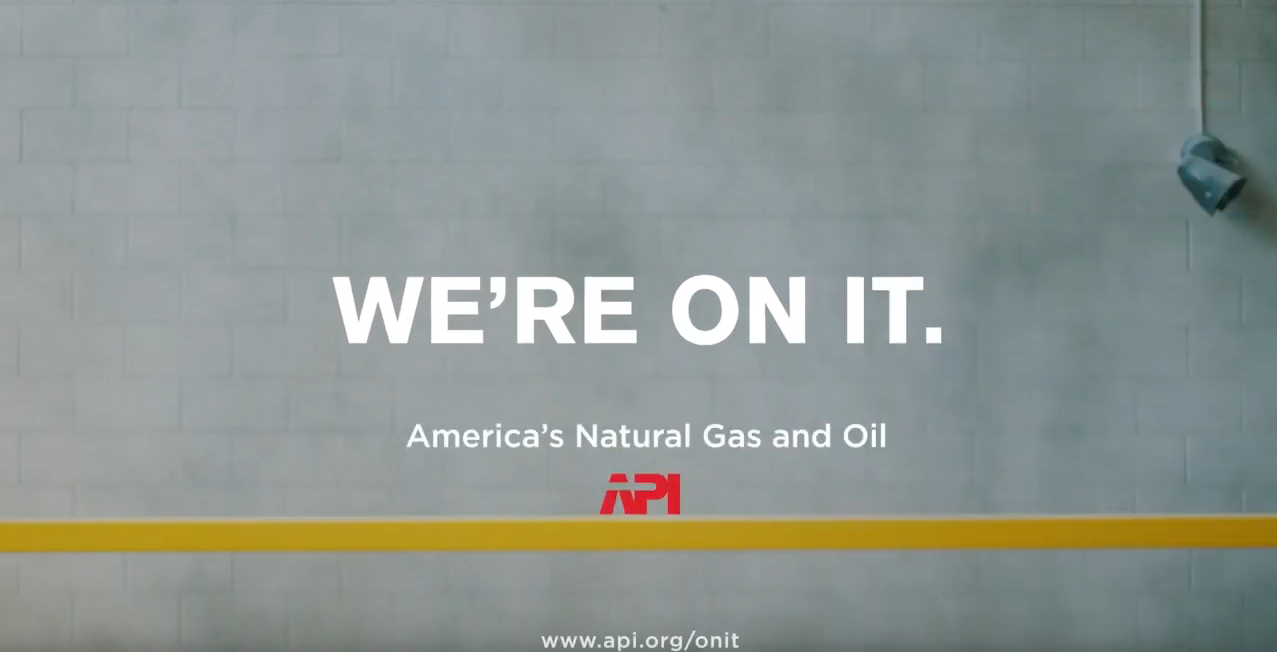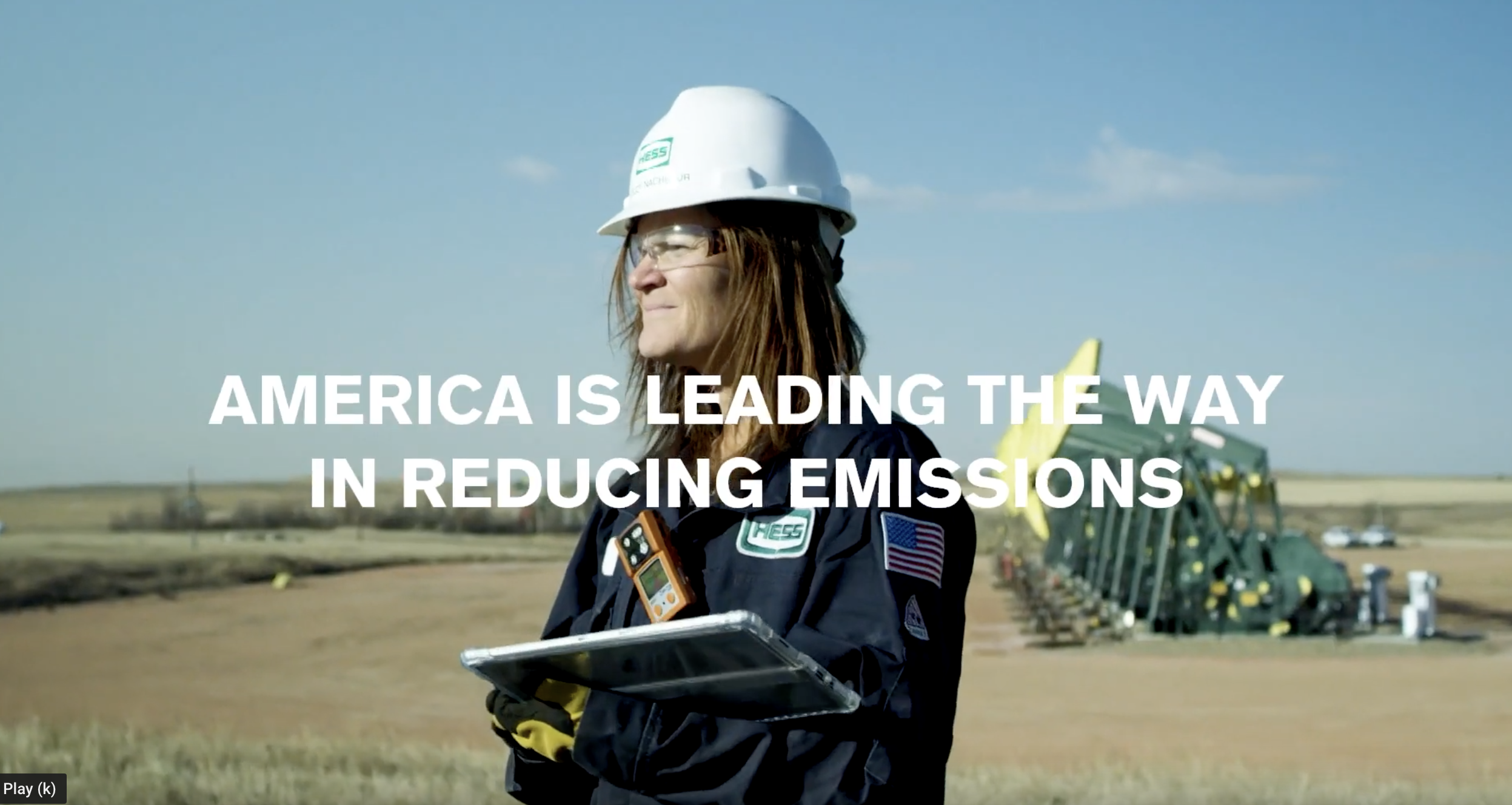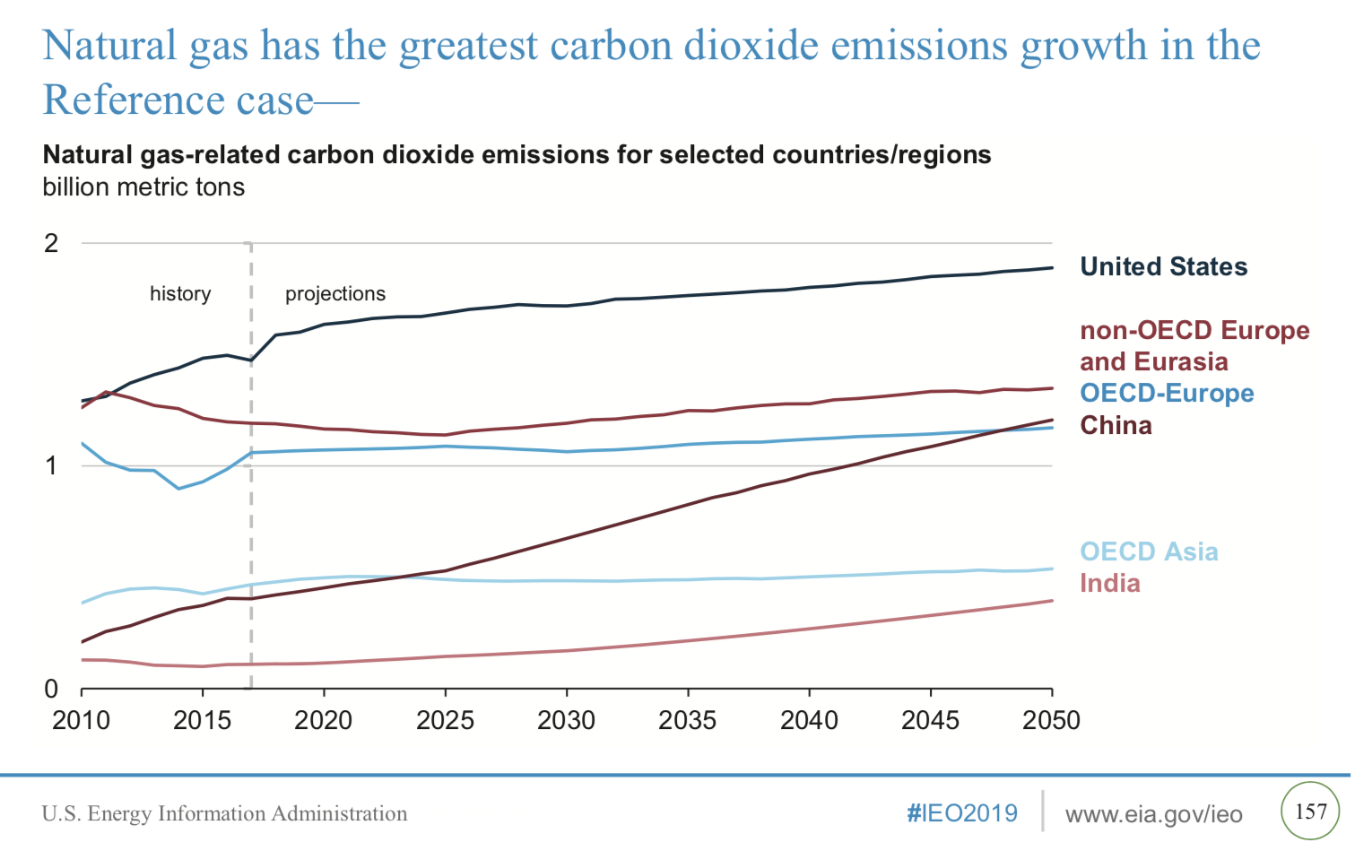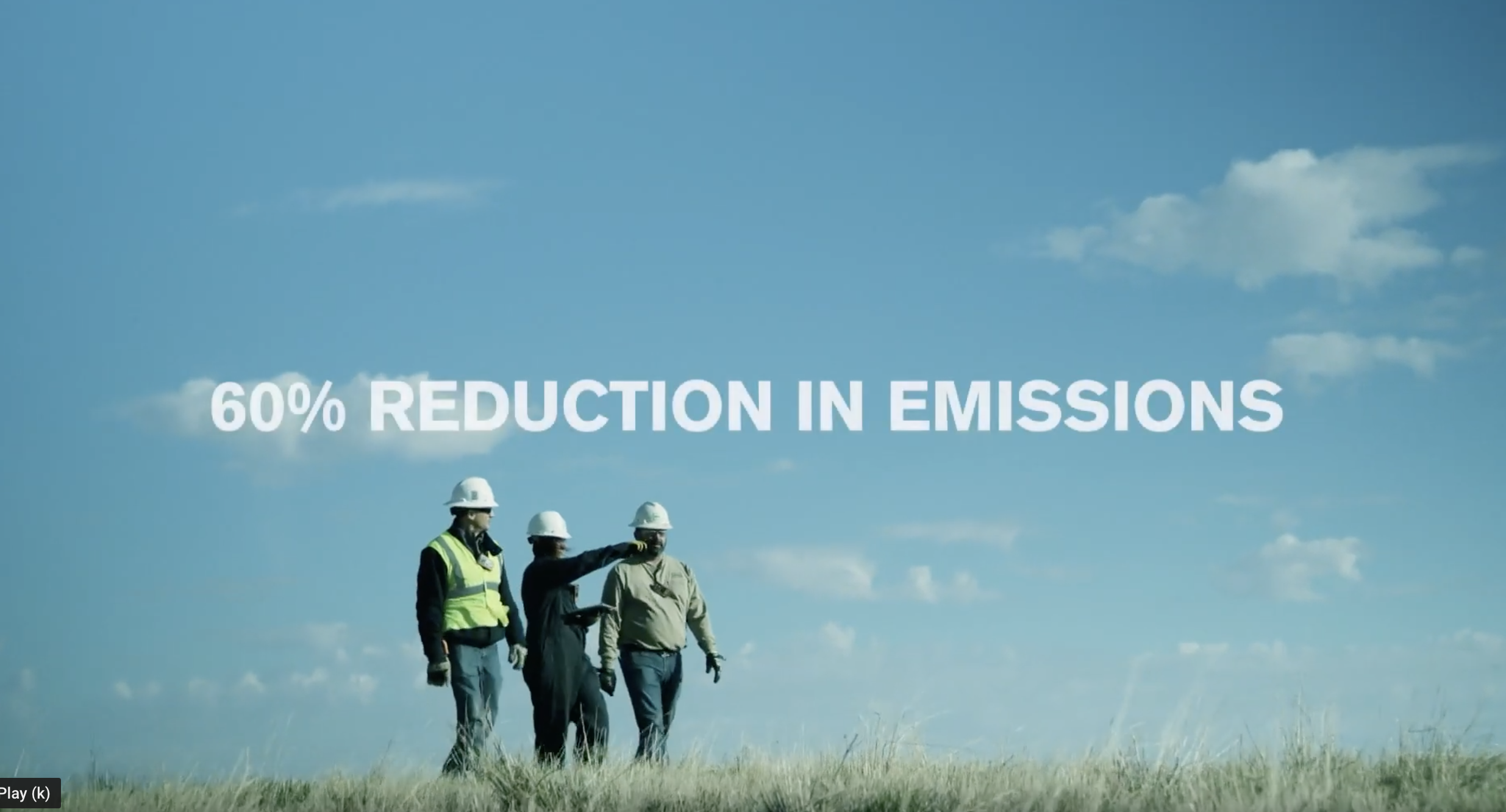In 1998, the U.S.’s largest oil and gas industry lobbying group, the American Petroleum Institute (API), was involved with a communications plan whose goal was promoting “uncertainties in climate science” among the American public. Over 20 years later, their communications plan looks a little different but still needs fact-checking.
In September, API began running TV, billboard, and social media ads promoting natural gas as a climate solution. “Thanks to natural gas, the U.S. is leading the way in reducing emissions,” the ads claim, and “leading the world in cutting greenhouse gas emissions.” But is all of that true?
In fact, U.S. carbon dioxide emissions actually rose 3.4 percent in 2018. While API appears to be specifically referring to emissions from power generation — attributing those savings to the switch from coal power to natural gas — even the power sector saw emissions rise 1.9 percent last year.
From an American Petroleum Institute advertisement.
It’s true that U.S. CO2 emissions are down from the peak of 2005, which was a period of booming economic growth, but it was followed by a major recession just a couple years later. It’s also true that replacing coal with natural gas for electricity has contributed in part to that reduction, but so has the rise of solar and wind power and battery storage.
However, emissions from transportation — the direct result of burning oil produced by the petroleum industry — also increased in 2018. With the Trump administration aiming to weaken fuel efficiency standards, that rise in transportation emissions is likely to continue.
While the oil and gas industry — or as API‘s new ads call it, “the natural gas and oil industry” — is touting natural gas as a way to decrease emissions, the U.S. Energy Information Administration predicts that natural gas will have the greatest increase in carbon dioxide emissions growth of any fuel source through 2050. That would make the U.S. a world leader in increasing CO2 emissions from natural gas.
A reference case scenario in the 2019 Annual Energy Outlook forecasts considerable growth in carbon dioxide emissions in the U.S., and globally, from natural gas. Credit: U.S. Energy Information Administration
About That Methane…
All of this so far is only focused on carbon dioxide emissions, but when discussing emissions and natural gas, you can’t leave out methane, a potent but short-lived greenhouse gas that is the primary constituent of natural gas. (Methane is also emitted by other sources, such as wetlands, landfills, and livestock.)
In one of the new API ads, viewers are presented with the claim that the largest producing oil and gas regions have seen a “60 percent reduction in emissions,” a point prominently flashed across the screen.
From an American Petroleum Institute advertisement.
At first glance, that seems like a great accomplishment, but a close listen to the video’s narrator (and a close reading of the API website) reveals the industry has reduced emission rates, not overall emissions, by 60 percent in the most productive oil and gas fields. That means greenhouse gas emissions are not increasing in these regions as fast as they once were, but that doesn’t mean they are going down.
However, methane emissions, both in the U.S. and globally, have surged in the past decade, and a 2019 Cornell University study points to fracked shale oil and gas production as a major culprit. Considering how much more powerful methane is at warming the climate compared to CO2 in the short term, these claims by API are misleading at best.
The Trump administration has proposed rolling back a regulation addressing methane leaks from oil and gas production, a move broadly opposed by large oil and gas companies like Exxon and BP but welcomed by API and the smaller firms it also represents.
Erik Milito, a vice president at API, voiced his support for replacing the methane rule with a looser one, telling the New York Times, “We think it’s a smarter way of targeting methane emissions.”
Meanwhile, global methane emissions continue to rise.
Flaring and Venting
As DeSmog has reported, the flaring and venting, or burning and direct release, of natural gas as part of the U.S. fracking industry is largely unregulated. These common oil and gas field activities are contributing to increasing carbon dioxide and methane emissions in states like North Dakota and Texas.
In Texas, the industry, while drilling for oil, is flaring enough natural gas to power the entire state, but because the gas is just being burned out in the oil fields, it’s not actually powering anything.
“It’s a black eye for the Permian basin,” Pioneer Natural Resources CEO Scott Sheffield said at an energy conference at Columbia University this spring. “The state, the pipeline companies, and the producers — we all need to come together to figure out a way to stop the flaring.”
Bottom line: the switch from coal to natural gas reduced CO2 emissions, but methane emissions increased substantially. And on the time scale of the next 20 years, the increased methane emissions completely overcame the reduced CO2 emissions. https://t.co/6Ca2WXwvGX
— Robert Howarth (@howarth_cornell) October 10, 2019
One way to stop flaring would be federal or state rules banning or limiting the practice, coupled with strong oversight from regulators. But in industry-friendly states like Texas and North Dakota, regulators have failed to enforce any real restrictions on flaring, and so the problem continues to grow.
The fracking industry has been losing money for more than a decade, which means shale oil firms are eager to keep costs low in an already expensive business. Flaring and venting natural gas, which is in oversupply and fetching low prices, saves these firms money when the alternative is building pricey pipelines and processing plants to otherwise deal with it. Ethan H. Bellamy, senior research analyst at Baird Equity Research, summed up the situation: “The business and regulatory question is what to waste, money or molecules?”
As always, the question comes back to profits. And the industry’s answer to that question is to “waste” molecules of natural gas by flaring or venting because this practice allows fracking firms to lose less money than they otherwise would, while still paying executive salaries and bonuses.
Even the International Energy Agency (IEA) realizes this problem with natural gas.
IEA executive director Fatih Birol recently told CNBC, “When you look at the future, the Achilles heel of the gas industry is the methane emissions.”
Despite the American Petroleum Institute’s new advertising claims, shifting power sources to natural gas won’t stave off the climate crisis.
But as viewers of API‘s new ad, “Together, We’re On It,” will note, the industry is starting to acknowledge public unrest over these issues. Framing it as “the energy debate,” the ad shows a young man sitting in a diner, watching a video of protesters on his laptop as a similar protest — perhaps the hoards of climate strikers who were slated to take the streets in September — marches by, reflected in the window.
Meanwhile, a sympathetic female narrator attempts to soothe this unrest, saying, “The energy debate, the pundits, the chatter, it’s constant. It can feel overwhelming,” before pivoting to a talking point about “the millions of problem solvers working in natural gas.”
Is the Gas Boom Already Over?
The oil and gas industry has been shifting its PR narrative in recent years, with some like API trying to convince the world that natural gas is a climate solution, as companies move to lock in future demand by rapidly building new gas pipelines, power plants, and other infrastructure.
That’s despite reports like those from the nonpartisan but pro-clean energy nonprofit the Rocky Mountain Institute, which recently forecast that up to 90 percent of natural gas power plants (and many pipelines) may be more expensive to run than renewables by 2035. Reports like these show natural gas is a bad investment for both economics and a livable climate.
Along those lines, a recent headline from oil and energy news site Oilprice.com should concern natural gas investors, asking, “Is The U.S. Gas Boom Already Over?”
The U.S. natural gas industry, whose growth largely has been driven by advances in fracking and drilling technology, has been plagued by losses, and investors are apparently getting tired of loaning money to companies that make it disappear.
Had an interesting lunch with @brucenilles today and heard about how the decline of natural gas, just like the decline of coal, is going to happen faster than people expect & catch industry flat-footed.
— David Roberts (@drvox) October 9, 2019
It isn’t hard to understand why API is now marketing natural gas using language about emissions reductions and energy demand. Rising pressure is coming from a public concerned about the climate crisis and from the increasingly cost-competitive renewables and storage industry.
An excellent example of this economic pressure came earlier this month. A northwest power company owned by billionaire Warren Buffet’s investment firm Berkshire Hathaway — which has no problem investing heavily in oil and gas — recently announced plans to shut down most of its coal plants serving Washington, Oregon, Wyoming, and Utah, and replace them with renewables and battery storage by 2038. That’s despite the abundance of very cheap natural gas in the U.S.
API knows the industry is feeling the heat, and it looks to be employing the same misinformation playbook that it used to sow doubt about the well-supported science of climate change and the resulting action the science demands.
Main image: From the American Petroleum Institute’s new ad “We’re On It.” Credit: API
Subscribe to our newsletter
Stay up to date with DeSmog news and alerts









